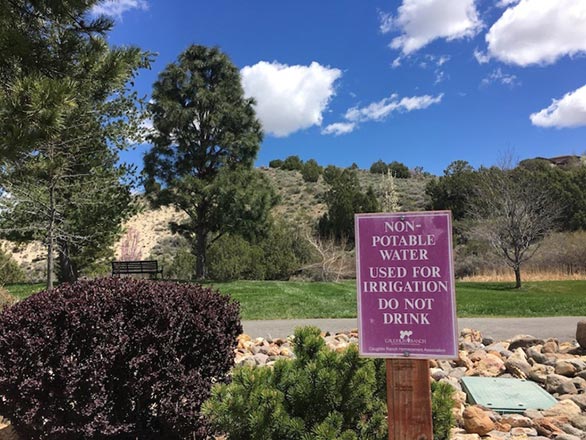Introduction
Reclaimed water is commonly defined as treated municipal wastewater that is able to be used again, a practice known as water reuse. Municipal water reuse in the United States occurs mostly in California, Florida, Arizona and Texas; but it is growing in other states, including Nevada.
What is reclaimed water?
In cities, municipal wastewater is typically cleaned through a series of mechanical, biological and chemical processes to ensure it is safe and sanitary prior to being released to a natural body of water. Wastewater treatment systems, initially designed to preserve human and environmental health, have advanced to a level where this wastewater can be reclaimed and safely used for other purposes. Reclaimed water, also known as recycled water, or repurified water, is used for a variety of beneficial purposes, such as landscape irrigation, industrial processes, toilet flushing or drinking.
There are no federal standards that directly govern reclaimed water use in the U.S. The U.S. Environmental Protection Agency established comprehensive Guidelines for Water Reuse, but leaves states with the responsibility of developing regulations (U.S. EPA, 2012). Many states, including California, Arizona, Texas and Nevada, have developed regulations to support and encourage greater water reuse.
In Nevada, reclaimed water is defined as “water that has received at least secondary water treatment and is reused after flowing out of a wastewater treatment facility” (Nevada Department of Conservation and Natural Resources, nd). Secondary wastewater treatment defines the minimum standard for legal discharge of treated wastewater into waterways in the U.S. The quality of reclaimed water depends on the level and type of wastewater treatment. As a result, reclaimed quality can be treated to match predefined water quality standards and disinfected to levels necessary for the chosen method of reuse (NDEP, 2014). In Nevada, reclaimed water use falls into six different categories depending on its quality, ranging from A+ though E. The quality categories and allowable uses for reclaimed water are included in Table 1. Use the link at the bottom to download tables.
In Nevada, potable and nonpotable uses of reclaimed water are allowable, as indicated in Table 1. Nonpotable water is water not suitable for human consumption but that can be used for other purposes, such as landscape irrigation, dust control or toilet flushing. Nonpotable reclaimed water is delivered in purple pipes, which indicates the lesser-quality reclaimed water. Potable water is water that is suitable for human consumption (e.g., drinking).
Reclaimed water is not the same as graywater. Graywater is defined as “wastewater from a household or small commercial establishment which
specifically excludes water from a toilet, kitchen sink, dishwater or water used for washing diapers” (Nevada Department of Conservation and Natural Resources, nd). Unlike reclaimed water, graywater does not undergo treatment. In graywater systems, the wastewater from bathroom sinks, tubs or washing machines is used to water lawns, landscapes or for other nonpotable purposes (Ormerod, 2016). The various types of water reuse are included in Table 2. Use the link at the bottom to download tables.
One of the most common uses for nonpotable reclaimed water is landscape irrigation (NDEP, 2014), which is often indicated by purple signs, as illustrated in Figure 1. Although drinking reclaimed water is a less common use, potable reuse has been adopted in several U.S. cities (U.S. EPA, 2012). Two of the better-known examples of potable reuse in the U.S. are located in Los Angeles County and Orange County, California (U.S. EPA, 2017). Recently, the National Research Council claimed, “[t]he uses of reclaimed water to augment potable water supplies has significant potential for helping to meet the nation’s future need” (National Research Council, 2012).

Figure 1. Typical purple compliance sign for reclaimed water used for landscape irrigation. The language and color signals nonpotable water quality.
Options for supplying reclaimed water are divided into direct or indirect. (See Table 2) Indirect reuse involves blending treated reclaimed water within an environmental buffer before normal drinking water treatment and delivery. Direct reuse involves adding reclaimed water directly to water supply without use of an environmental buffer, for example, by sending reclaimed water to the raw water feed for a drinking water facility.
An update to Nevada’s regulations in 2016 allows for potable reuse based on new reuse category of “A+” water, which is the highest quality of reclaimed water (NDEP, 2016). These regulations expanded reclaimed water uses to allow for indirect potable reuse through groundwater augmentation. Groundwater augmentation involves placing highly treated reclaimed water into an aquifer (groundwater table) to be extracted and treated later by a water treatment facility. The Nevada Water Innovation Institute at the University of Nevada, Reno, is currently collaborating with local agencies to explore the feasibility and long-term benefits of implementing indirect potable reuse in northern Nevada.
In Nevada, reclaimed water use is administered by the Bureau of Water Pollution Control within the Nevada Division of Environmental Protection, who provides oversight and issues discharge permits according to NAC 445A.275 and NAC 445A.276. Per the permitting requirements, all reclaimed water application must be prepared by a registered professional engineer (Nevada Division of Environmental Protection, 2017). Related information about the existing regulations and permitting processes specific to Nevada is available in the Extension fact sheet FS-20-11, Reclaiming Water for Urban Foodsheds: State of Nevada Regulations and Permitting (Sterle, et al., 2020).
To learn more about reclaimed water use in Nevada, visit the Nevada Division of Environmental Protection website.
For the complete document with tables, figure and reference use the link below to download the PDF version.


